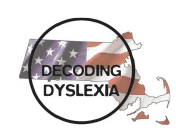Dyslexic students can learn to read.
The International Dyslexia Association has established standards and practices that have been studied and validated for teaching reading to students with dyslexia. Evidence based on brain imaging from studies at Stanford recently showed that this structured approach to reading benefited both typical and dyslexic readers. Check their Center for Effective Reading for accredited programs and certifications.
The National Reading Panel identifies Five Components of Reading Instruction and as for all kids these areas, Phonemic Awareness, Phonics, Fluency, Vocabulary, and Comprehension are used for instruction and assessment.
For all students structured explicit instruction is ideal - but for students with dyslexia - explicit sequenced and systematic language instruction is the only science based way to build reading skills.
Parents can learn more about literacy skills and help.
These are the basic stages of reading development.
1. Foundational Skills
Literacy How Logic of English 3. FluencyFluency is more than words per minute! This stage consolidates skills of the previous stages and builds on these to increase automaticity.
Fluency is achieved when a student reads with accuracy, automaticity, prosody and comprehension. Fluency can be improved when:
|
2. Decoding and EncodingDecoding involves matching the sounds of the language (English) to the symbols we use.
4. Reads to Learn
|
5. Multiple Views
- Deals with layers of multiple concepts
- Various points of view
- Technically specific and more advanced vocabulary.
- Analytical processing
- Complex syntax
Multi-sensory learning : learn more with IDA International Dyslexia Asscociation
- Joshi, Dahlgren, and Boulware-Gooden (2002)
- Glenberg, Gutierrez, Levin, Japuntich, and Kaschak (2004)
- Glenberg, Brown, and Levin (2007)
Joshi, Dahlgren, and Boulware-Gooden (2002) provide an empirical demonstration that systematic, research-based reading instruction is crucial at the early elementary grade levels and that systematic synthetic phonics instruction (in particular, instruction following the principles of the Orton-Gillingham method) for the very early grades is effective in combating reading failure. In their one-year study of first graders, the authors found that multisensory teaching techniques that combined all three learning modalities—auditory, visual, and kinesthetic, first-grade students made significant gains in phonological awareness, decoding, and reading comprehension. However, first- grade students in the control group also made significant gains in reading comprehension.
A study conducted by Glenberg, et al. (2004) on object manipulation versus read-reread demonstrated
that object manipulation can greatly enhance first and second graders’ reading performance. Students using
the manipulation technique scored higher on critical action-sequence questions and temporal order questions than those who did not. Glenberg, et al. (2006) also found that object manipulation had a positive effect on students’ reading comprehension when used in smaller groups. This was true for students in both individual and peer settings.
Object manipulation appears to help students draw inferences necessary to construct integrated mental models. A mental model is often conceptualized as a representation that goes beyond information explicit in the text by incorporating a student’s inferences and world knowledge: thus the mental model becomes a representation of what the text is about rather than a representation of the text itself.
This research has demonstrated an approach to language comprehension—the use of physical manipulation and even imagined manipulation—that suggests a powerful teaching technique. However, before recommending this technique for classroom use, researchers must demonstrate that it works with longer and more realistic texts and that the results of using the technique do not fade as students become more familiar with the process. Furthermore, research needs to demonstrate that students can be taught to move from physical representations of story-relevant objects to mental images.
Watch these to learn more
Advice for parents where to start: |
Social Emotional Considerations for Dyselxia
|
|
|
|
